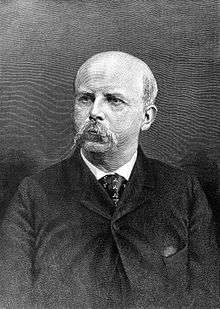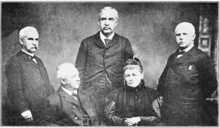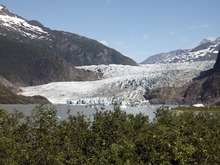Thomas Corwin Mendenhall
| Thomas Corwin Mendenhall | |
|---|---|
|
Thomas Corwin Mendenhall | |
| Born |
October 4, 1841 Hanoverton, Ohio, USA |
| Died |
March 28, 1924 (aged 82) Ravenna, Ohio, USA |
| Nationality | US |
| Fields |
gravity physics seismology meteorology |
| Alma mater | Ohio State University |
| Known for |
gravity physics |
| Influences | Augustus De Morgan |
| Influenced |
Yamakawa Kenjirō Tanakadate Aikitsu |
| Notable awards |
Cullum Geographical Medal (1901) Franklin Medal (1918) Order Of The Sacred Treasure(Japan) (1911) |
Thomas Corwin Mendenhall (October 4, 1841 – March 23, 1924) was an American autodidact physicist and meteorologist. Alongside his work, he was also an advocate for the adoption of the metric system by the United States.
Biography
Mendenhall was born in Hanoverton, Ohio to Stephen Mendenhall, a farmer and carriage-maker, and Mary Thomas. In 1852 the family moved to Marlboro, Ohio a Quaker community outside of Akron, Ohio. His parents were strong Abolitionists and frequently opened their home to escaped slaves heading north along the Underground Railroad. Mendenhall became principal of the local primary school in 1858. He formalized his teaching qualifications at National Normal University [1] in 1861 with an Instructor Normalis degree.[2]

While living in Columbus, Ohio he married Susan Allan Marple in 1870. The couple had one child, Charles Elwood Mendenhall(1872-1935), teacher and chairman of the Physics Department at University of Wisconsin-Madison for 34 years.[3]
He taught at a number of schools in Ohio including Central High School (Columbus, Ohio)[4] gaining an impressive reputation as a teacher and educator until 1873 when, although lacking conventional academic credentials, he was appointed professor of physics and mechanics at the Ohio Agricultural and Mechanical College. The College ultimately became Ohio State University,[2] Mendenhall being the first member of the original faculty.[5] He was later awarded the first ever Honorary Ph.D. from Ohio State University in 1878.[5]
In 1878,[2] on the recommendation of Edward S. Morse,[6] he was recruited to help the modernization of Meiji Era Japan as one of the o-yatoi gaikokujin (hired foreigners), serving as visiting professor of physics at Tokyo Imperial University. In connection with this appointment, he founded a meteorological observatory to make systematic observations during his residence in Japan. From measurements using a Kater's pendulum of the force of gravity at the sea level and at the summit of Mount Fuji [7] Mendenhall deduced a value for the mass of the Earth that agreed closely with estimates that Francis Baily had made in England by another method. He also made a series of elaborate measurements of the wavelengths of the solar spectrum by means of a large spectrometer.[6] He also became interested in earthquakes while in Japan, and was one of the founders of the Seismological Society of Japan (SSJ).[6] During his time in Japan, he also gave public lectures on various scientific topics to general audiences in temples and in theaters.[2]
Returning to Ohio in 1881, Mendenhall was instrumental in developing the Ohio State Meteorological Service. He devised a system of weather signals for display on railroad trains. This method became general throughout the United States and Canada.
He became professor at the US Signal Corps in 1884, introducing of systematic observations of lightning, and investigating methods for determining ground temperatures. He was the first to establish stations in the United States for the systematic observation of earthquake phenomena.

Resigning in 1886, Mendenhall took up the presidency of the Rose Polytechnic Institute in Terre Haute, Indiana before becoming superintendent of the U.S. Coast and Geodetic Survey in 1889. During his time as superintendent, he issued the Mendenhall Order and oversaw the consequent transition of the United States's weights and measures from the customary system, based on that of England, to the metric system.[6] Mendenhall remained a strong proponent for the official adoption of the metric system all his life. Also, as superintendent of the U.S. Coast and Geodetic Survey, he was also responsible for defining the exact national boundary between the United States (Alaska) and Canada. The Mendenhall Valley and glacier in Juneau, Alaska was named for him in 1892.[8]
The portable Mendenhall Gravimeter was invented in 1890 by Thomas Corwin Mendenhall while he was superintendent of the U.S. Coast and Geodetic Survey,[6] and at that time it provided the most accurate relative measurements of the local gravitational field of the Earth. The gravimeters were used at over 340 survey "stations" across the US and around the world including Germany, Holland, Java, Philippines, Cuba, Haiti, Bahamas, Dominican Republic, Panama, Canada, and Mexico. The swing of the pendulum was more regular than the most accurate clocks of the era, and as the "world's best clock" it was used by Albert A. Michelson to measure the speed of light, which he won a Nobel Prize for in 1907.[9] An early model of the original 1890's Mendenhall Gravimeter is on display at the Smithsonian Institution in Washington, D.C. [10]

Mendenhall was appointed president of the Worcester Polytechnic Institute from 1894 until 1901 when he emigrated to Europe.[2] He returned to the United States in 1912. He was appointed to the Board of Trustees of Ohio State University in 1919, and is remembered for his successful efforts to close the College of Homeopathic Medicine and his unsuccessful effort to limit the capacity of Ohio Stadium to 45,000 seats, contending that it would never be able to fill to its design capacity of 63,000 seats.[5] He continued to serve as a trustee until his death at Ravenna, Ohio in 1924.[2]
His portrait is currently part of the Smithsonian Institution National Portrait Gallery in Washington D.C. [11] painted by his former pupil Annie Ware Sabine Siebert, who was the first recipient of a Master of Arts degree from Ohio State University in 1886, and one of the first women to earn an architecture degree from MIT in 1888.
Work on stylometry
In 1887 Mendenhall published one of the earliest attempts at stylometry, the quantitative analysis of writing style.[12] Prompted by a suggestion made by the English mathematician Augustus de Morgan in 1851, Mendenhall attempted to characterize the style of different authors through the frequency distribution of words of various lengths. In this article Mendenhall mentioned the possible relevance of this technique to the Shakespeare Authorship Question, and several years later this idea was picked up by a supporter of the theory that Sir Francis Bacon was the true author of the works usually attributed to Shakespeare. He paid for a team of two people to undertake the counting required, but the results did not appear to support this particular theory.[13] It has however since been shown by Williams that Mendenhall failed to take into account "genre differences" that could invalidate that particular conclusion.[14] For comparison, in 1901 Mendenhall also had works by Christopher Marlowe analysed,[15] and those supporting the Marlovian theory that he was the true author seized eagerly upon his finding that "in the characteristic curve of his plays Christopher Marlowe agrees with Shakespeare about as well as Shakespeare agrees with himself."[16]
Honors

- Honorary Ph.D. from Ohio, (1878)[5]
- Member of the National Academy of Sciences, (1887)[2]
- LL.D. from the University of Michigan (1887)
- President of the American Association for the Advancement of Science (1889)[2]
- The Mendenhall Valley and glacier in Juneau, Alaska was named for him in (1892)[8]
- Cullum Geographical Medal of the American Geographical Society (1901)
- Order of the Sacred Treasure - Japan (1911)[6]
- Franklin Medal (1918)
- The Mendenhall Laboratory on the campus of The Ohio State University is also named in his honor.[17]
References
Notes
- ↑ "National Normal University, 1893 Alumnal Roster, Lebanon, Warren County, Ohio". www.rootsweb.ancestry.com. Retrieved 2016-09-24.
- 1 2 3 4 5 6 7 8 Carey (1999)
- ↑ "National Academy of Sciences - Biographical Memoir - Obituary" (PDF).
- ↑ "Dead body + electricity = spooky experiment conducted by first faculty". 2014-10-31. Retrieved 2016-09-24.
- 1 2 3 4 The Birth of Ohio Stadium
- 1 2 3 4 5 6 Drew, Sybil (2016-11-15). Self Styled Genius: The Life of Thomas Corwin Mendenhall (1 edition ed.). Jan & Brooklyn. ISBN 9780692790571.
- ↑ Hyakumeizan, Project (2011-06-26). "One Hundred Mountains: The o-yatoi who weighed the earth". One Hundred Mountains. Retrieved 2016-09-24.
- 1 2 Mendendall Glacier Visitor Center home page
- ↑ "Albert A. Michelson - Biographical". www.nobelprize.org. Retrieved 2016-10-03.
- ↑ "Mendenhall Gravity Pendulums". National Museum of American History. Retrieved 2016-09-24.
- ↑ "National Portrait Gallery - Mendenhall Portrait".
- ↑ Mendenhall (1887)
- ↑ Mendenhall (1901) p.104
- ↑ Williams (1975)
- ↑ www.pnas.org
- ↑ Mendenhall (1901) p.105
- ↑ Alexander (1926)
Bibliography
Works by Mendenhall
- Mendenhall, T. C. (1887). A Century of Electricity. New York: Houghton, Mifflin and Co.
- Mendenhall, T. C. (1887). "The Characteristic Curves of Composition". Science. IX (214): 237–248. doi:10.1126/science.ns-9.214s.237.
- Mendenhall, T. C. (1901). "A Mechanical Solution of a Literary Problem". The Popular Science Monthly. LX (7): 97–105.
Obituary
- Science, 11 July 1924
Works about Mendenhall
- Alexander, W. H. (1926). "Report of the thirtysixth annual meeting of the Ohio Academy of Science". Ohio Journal of Science. 26 (4): 185–186. External link in
|title=(help) - Crew, H. (1934). "Thomas Corwin Mendenhall". Biographical Memoirs of the National Academy of Sciences. 16: 331–315.
- Joncich, G. (1966). "Scientists and the schools of the nineteenth century: The case of American physicists". American Quarterly. 18 (4): 667–685. doi:10.2307/2711389.
- Williams, C. B. (1975). "Mendenhall's Studies of Word-Length Distribution in the Works of Shakespeare and Bacon". Biometrika. 62 (1): 207–212. doi:10.1093/biomet/62.1.207. (subscription required)
- Rubinger, Richard (1989) American Scientist in Early Meiji Japan: The Autobiographical Notes of Thomas C. Mendenhall, ISBN 0-8248-1177-1
- Carey, C. W. (1999) "Mendenhall, Thomas Corwin", American National Biography, Oxford University Press, 15: 297-298, ISBN 0-19-520635-5
- [Anon.] (2001) "Mendenhall, Thomas Corwin", Encyclopaedia Britannica, Deluxe CDROM edition
- Hebra, A. & Hebra, A. J. (2003) Measure for Measure: The Story of Imperial, Metric, and Other Units ISBN 0-8018-7072-0
- Drew, Sybil (2016) Self Styled Genius: The Life of Thomas Corwin Mendenhall ISBN 978-0692790571
External links
| Government offices | ||
|---|---|---|
| Preceded by Frank Manly Thorn |
Superintendent, United States Coast and Geodetic Survey 1889–1894 |
Succeeded by William Ward Duffield |
